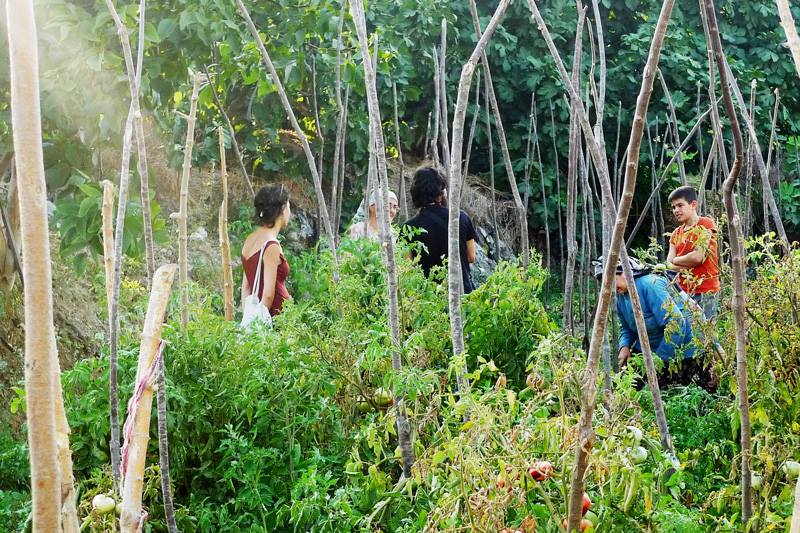There has been little international reporting on Istanbul this week. No news not good news. The assault on Turkey’s heritage is unrelenting. One report that did come out concerned the city’s famous Theodosian land walls, which we reported on last week. The article, by the New Yorker writer Elif Batuman, is sadly typical of a thousand other stories not aired outside Turkey.
‘Turning a corner, we came upon an intact stretch of bostans – lush, green rectangles spreading out to the horizon,’ writes Batuman in Istanbul's Troubled Gardens.

‘The bostans (market gardens) of Yedikule line the southern edge of the fifth-century walls that enclosed Byzantine Constantinople. The gardens may be as old as the walls. An edict in the Theodosian Code (422 A.D.) designates space in the walls’ towers for storing produce and farming implements; a sixth-century Byzantine text mentions the cultivation there of “a large variety of green salads, endive, carrots, onions, and cabbage”. To this day, the Yedikule bostans are known for their salad greens, particularly a special lettuce.’
The land walls have always exerted a fascination, and not merely because they go on for mile after mile – at this time of year it is the emerald-green beds of purslane that catch the eye in the warm evening sun. Against a backcloth of late Roman walls, the lovingly tended parterres, divided by orchards of mulberry and fig, are completely bewitching. The fact that the green is edible makes it even more intoxicating. This week the photographer Fritz von der Schulenburg visited Istanbul to lend his magic to Cornucopia's forthcoming Istanbul issue (out in October), The walls were his first port of call as we drove into town from the airport. Alas the first garden we parked by had been vandalised last week. Where the previous week there had been a carpet of freshly emerging parsley, there was now a scrubland of dust.
As Batuman explains, ‘Just over a week ago, bulldozers started burying the bostans – located in the rich, fertile soil of a former moat – under several feet of rubble. The rubble will then be covered by a layer of “low-quality soil” and turned into a ninety-thousand-square-metre park with cafés and an artificial river. (The style seems consistent with a nearby luxury housing development of recent construction.)’ Is worse to follow?

This photograph by Fritz von der Schulenburg shows the bostans outside the walls as they still look today. Every square foot in immaculate order, a paradise of organic gardening in the very heart of the largest metropolis in Europe. It is every modern town-planner's dream.

And this is what the Fatih Municipality want. A supermarket-style makeover. Not only will any sense of history have been eradicated inside the walls, but the gardens outside will levelled andpaved over. The city council is unaware that it is destroying a place of unique beauty, a way of life that has seen the city through 1600 years of turbulent history, and a site of incomparable archaelogical significance.
This is not the first assault on these ancient walls in recent times. Dreadfully hasty and misguided restoration by the mayor Berdrettin Dalan, involved copious tons of concrete. It was condemned by John Julius Norwich and others in Cornucopia 7 (1995). That kind of restoration is fortunately rarely seen today, yet historic Istanbul and a sense of genus locii is clearly anathema to our civic rulers.
Two factors lie behind the latest attack. For the 2020 Olympics, assuming Istanbul wins the vote of certain contract-hungry countries, vast giant swimming pool complexes are to be thrown up alongside the walls. And more pressingly, a large station is being built inside the walls at Yedikule to serve the Marmaray rail project, linking the Asian to the European shores of Istanbul. This utterly charming backwater is about to become highly desirable real estate. The speculators are in a frenzy.
But does an increase in real estate value necessitate the destruction of the historic fabric? Are London, Rome, Paris and the beautiful cities of Tuscany, Provence or Andalusia any poorer for retaining their sense of age? Istanbul is wonderfully old and mighty city. Must we be ashamed of its past and its wonderful produce?

Much has been learnt from Gezi Park. Conservations determined to establish a coherent resistance to the plans have been feverishly holding meetings and forums. The legality of the new project is clearly suspect – it goes against the council's stated policy, which promised to retain bostans, so a courtcase is likley. On Monday a petition will be handed in to the mayor of Fatih, the man responsible for guarding the heritage of Istanbul's historic peninsula, asking him to conserve the most historically important gardens in Europe.
It is too late to save them all – the damage inflicted by the bulldozers is irreversible – but at least the survivors should be saved. We wish the valiant protesters luck. May the gardeners of Yedikule continue to put their green fingers to good use. it is too early for the Yedikule lettuce, but lets hope they are still around in September.







































































